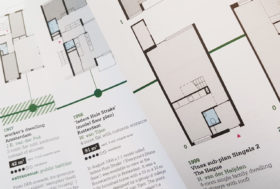21 May 2018 – There are two kinds of housing typology. The first studies extreme possibilities. I always call it the Sherwood School, after Roger Sherwood who wrote the famous reference book Modern Housing Prototypes. This approach is firmly about experiments with complicated sections and access systems. It produced a canon in which Siedlung Halen and the Unité d’Habitation, homes for Swiss and French bourgeoisie, are the highlights. I know these books well. The relevance of such experiments, designed by the heroes of high architecture, is not always clear to me.
The second kind of housing typology does not focus on the extremes, but looks at volume house building instead. This typology also celebrates its experiments. These do not produce extremist references. They are about the enhancement of the quality of the large numbers of housing. The authors of these experiments have remained largely unknown (although in North Amsterdam an entire neighbourhood is named after the house builder Jan Ernst van der Pek). I find this typology much more sympathetic – and more useful for my own work.
Recently, my colleagues of the architecture office Rijnboutt have published a ‘chronology of the housing floor plan’. It is a clear example of the second approach of housing typology. One cannot have too many of such studies. Rijnboutt made a timeline (starting at 1870) with plans of workers and middle-class dwellings. All these are newly drawn and supplied with key data, making them comparable.
The architects of this body of work include, except the already mentioned Van der Pek, figures like Van Loghem, Brinkman, Oud, Van Tijen and Van den Broek (and Kees Rijnboutt himself). It is and honour that one of my first housing schemes is included.
In the chronology, the social housing in Singels, Ypenburg illustrates the Vinex era in Dutch housing. Interesting in these dwellings is that their narrow width still provides for a good dining place at the street side. The ground floor plan is open, but offers the possibility to extend the entrance hall and to separate the staircase and the kitchen from the living room.

